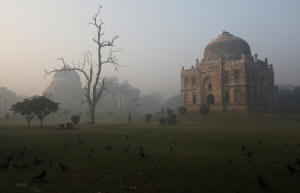New Delhi is world's most polluted capital for third straight year -
IQAir study
 Send a link to a friend
Send a link to a friend
 [March 16, 2021]
By Neha Arora [March 16, 2021]
By Neha Arora
NEW DELHI (Reuters) - New Delhi was the
world's most polluted capital for the third straight year in 2020,
according to IQAir, a Swiss group that measures air quality levels based
on the concentration of lung-damaging airborne particles known as PM2.5.
India was home to 35 of the world's 50 most polluted cities, according
to IQAir's 2020 World Air Quality Report, which gathered data for 106
countries.
The findings were based on the country's annual average of particulate
matter PM2.5, airborne particles with less than 2.5 microns in diameter.
Prolonged exposure to PM2.5 can lead to deadly diseases, including
cancer and cardiac problems.
In 2020, New Delhi's average annual concentration of PM2.5 in a cubic
meter of air was 84.1, the study said, more than double the level of
Beijing, which averaged 37.5 during the year, making it the 14th most
polluted city in the world.

Air pollution caused an estimated 54,000 premature deaths in New Delhi
in 2020, according to a recent study by Greenpeace Southeast Asia
Analysis and IQAir.
Despite an 11% reduction in the annual average of PM2.5 levels due to
nationwide coronavirus lockdown curbs imposed last year, India emerged
as the world's third most polluted country after Bangladesh and
Pakistan.
[to top of second column]
|

A general view of the Lodhi Garden on a smoggy morning in New Delhi,
India, December 23, 2020. REUTERS/Anushree Fadnavis

"Air pollution in India is still dangerously high," the report said.
In 2020, South Asia endured some of the world's worst air quality on
record, it said.
Last year, Delhi's 20 million residents, who breathed some of the
cleanest air on record in summer months due to the lockdown curbs,
battled toxic air in winter, following a sharp increase in farm fire
incidents in the neighbouring state of Punjab.
As the burning of crop stubble peaked, Delhi's PM2.5 levels averaged
144 micrograms per cubic metre in November and 157 micrograms per
cubic metre in December, exceeding the World Health Organisation's
annual exposure guideline by more than 14 times, it said.
(Reporting by Neha Arora; editing by Mayank Bhardwaj and Ed Osmond)
[© 2021 Thomson Reuters. All rights
reserved.] Copyright 2021 Reuters. All rights reserved. This material may not be published,
broadcast, rewritten or redistributed.
Thompson Reuters is solely responsible for this content. |